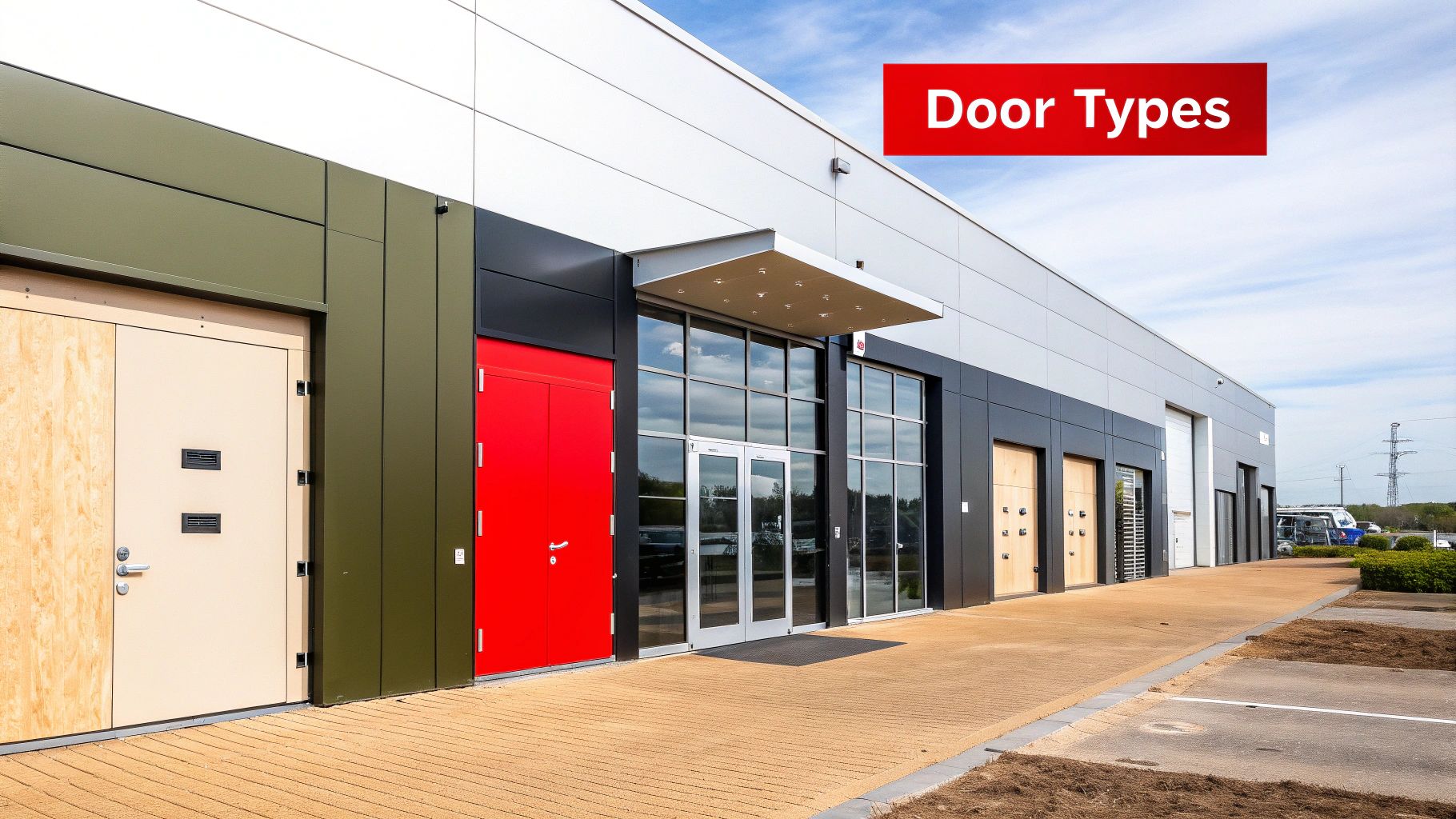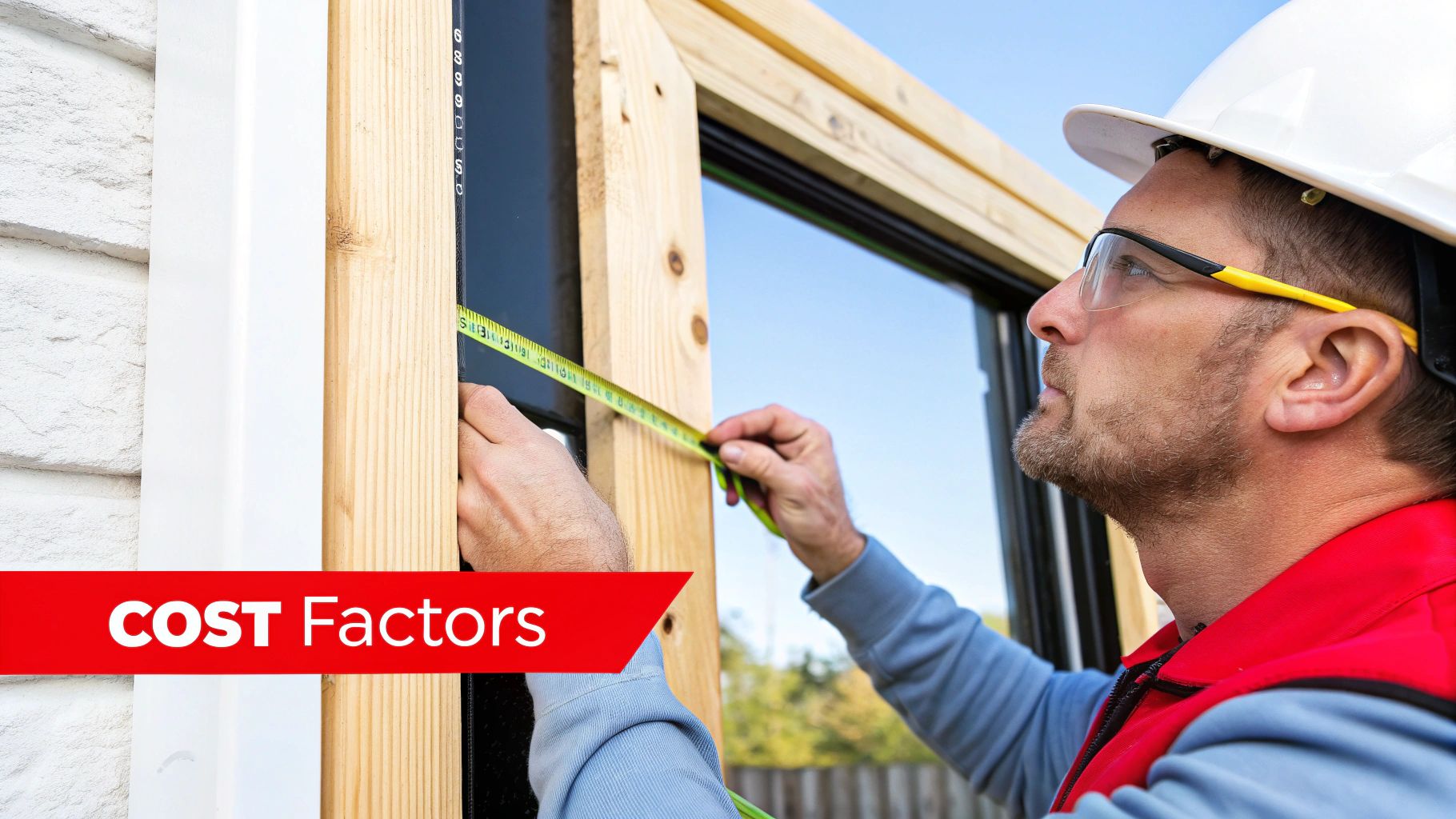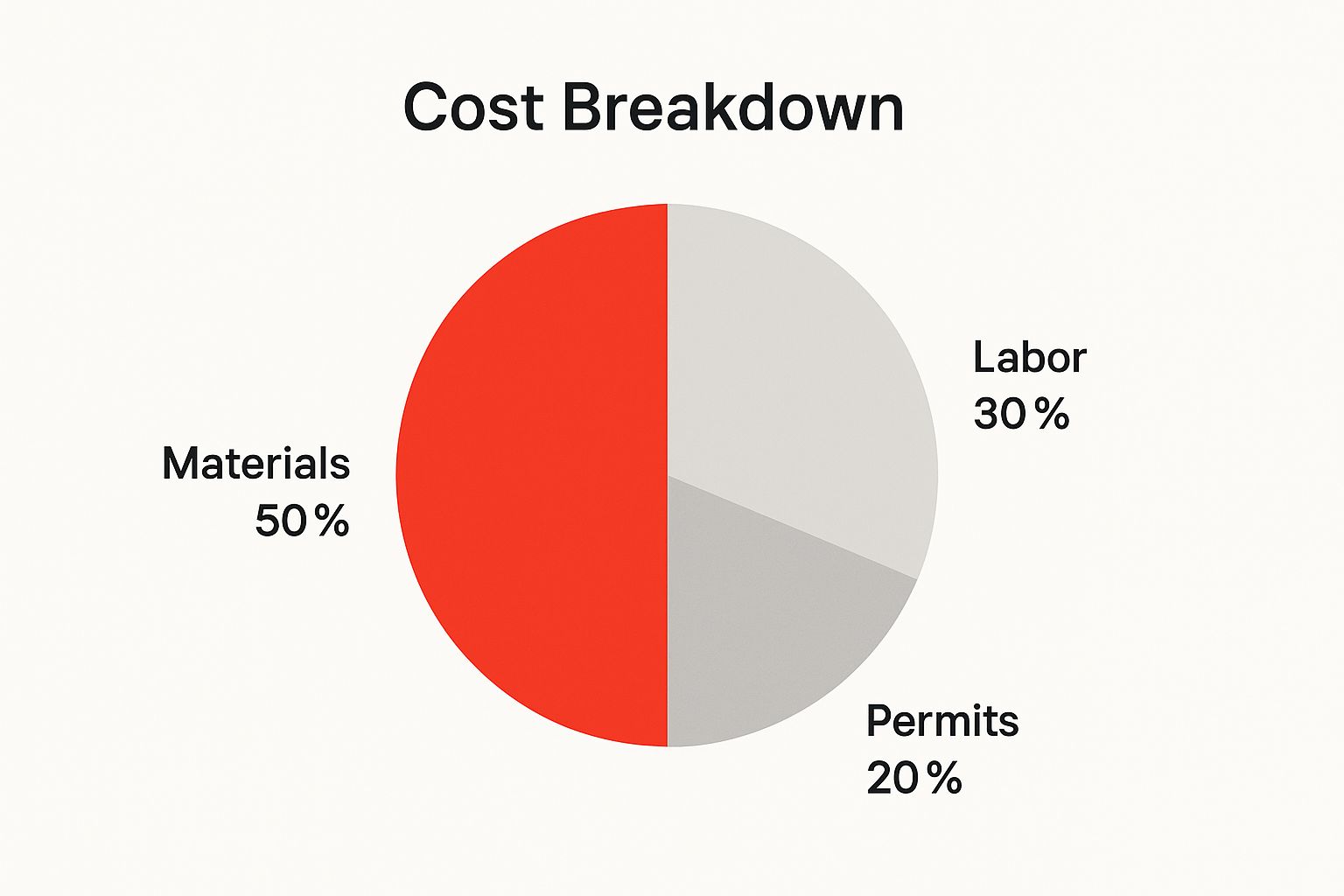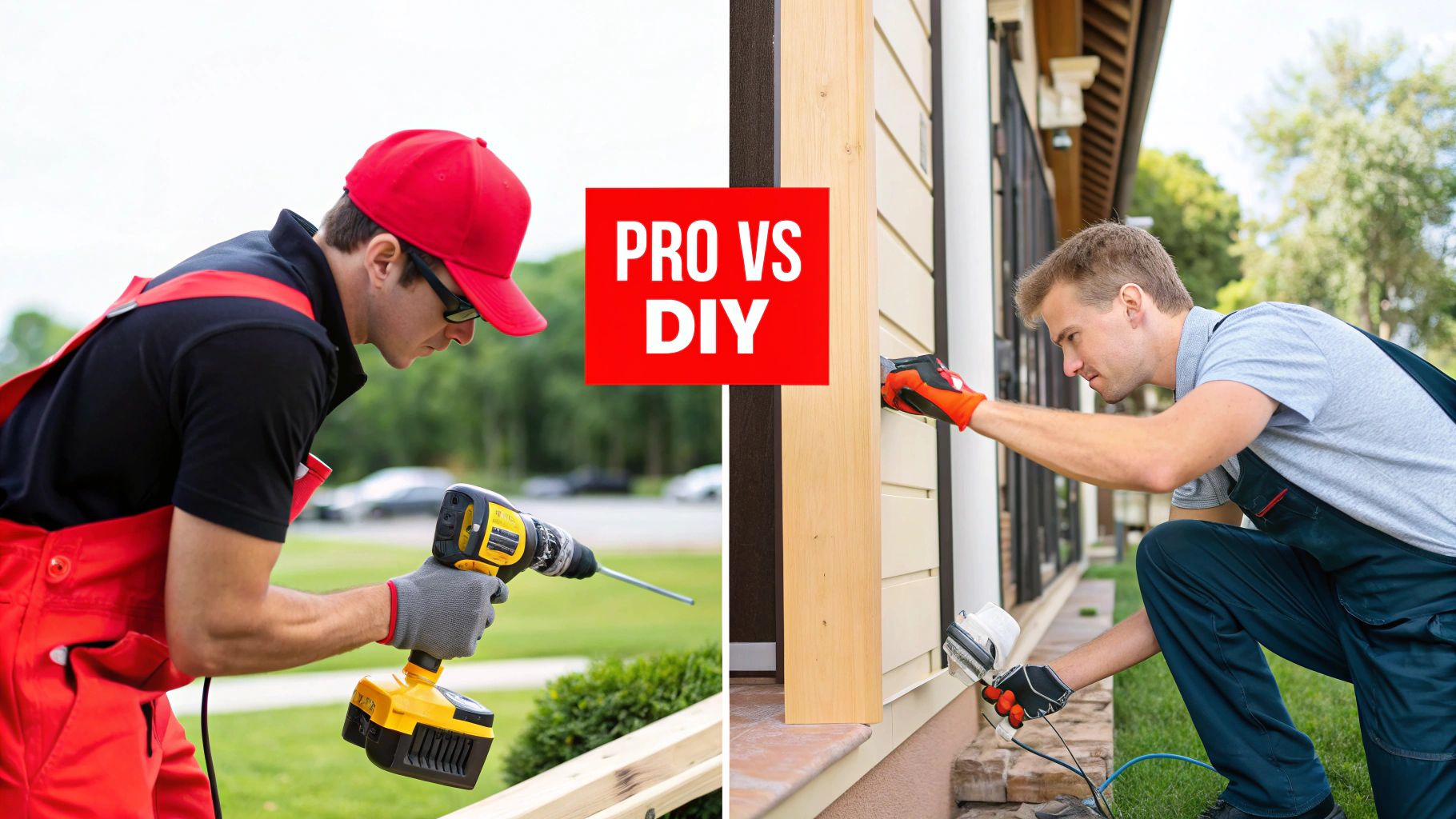Pinning down a firm commercial door installation cost can be a challenge, but for most standard projects in Texas and Oklahoma, business owners can expect the investment to land somewhere between $800 and $4,500. This range covers everything from a simple, secure steel door for a utility room to a modern aluminum and glass storefront system for a retail space.
Of course, the final invoice will be shaped by several key variables: the door's material, its compliance with codes like NFPA 80, any specialized security hardware, and the complexity of the installation itself. Understanding these factors is the first step to making a smart, long-term investment in your property's safety and functionality.
Your Guide To Commercial Door Installation Costs

When budgeting for a new commercial door, it's helpful to view the cost as a spectrum. On one end, you have basic, functional doors built for security and utility. On the other, you'll find advanced systems engineered for heavy foot traffic, specific fire ratings, or a high-end aesthetic.
The total commercial door installation cost is a combination of three core components: the door and frame (materials), the hardware (locks, closers, exit devices), and the skilled labor required for a compliant installation. For business owners in our Texas and Oklahoma service areas, breaking down these elements is the most effective way to budget for your building's safety and curb appeal.
A First Look At The Numbers
National averages provide a solid baseline. A standard hollow metal steel door, a workhorse in industrial settings, typically runs between $800 and $2,500 installed. An aluminum and glass storefront door—a popular choice for retail and office spaces—often falls in the $1,200 to over $4,000 range.
When you factor in specialized requirements, the price reflects the engineering. Fire-rated doors or high-security automatic systems can easily push the cost from $3,000 to $8,000 or more, which accounts for advanced materials and strict compliance standards. For a deeper look, pricing data from industry hardware specialists offers granular details on these figures.
Estimated Commercial Door Installation Costs At A Glance
To help you visualize the budget, here is a quick-reference table outlining typical costs for common commercial door types we install across Texas and Oklahoma.
| Door Type | Average Material Cost | Average Installation Cost | Total Estimated Cost |
|---|---|---|---|
| Hollow Metal (Steel) | $400 – $1,500 | $400 – $1,000 | $800 – $2,500 |
| Aluminum & Glass | $700 – $2,500 | $500 – $1,500 | $1,200 – $4,000 |
| Fire-Rated Door (Steel) | $800 – $2,000 | $400 – $1,500 | $1,200 – $3,500 |
| Automatic Sliding Door | $1,500 – $5,000+ | $1,500 – $3,000+ | $3,000 – $8,000+ |
Actionable Tip: These numbers are estimates. The final price can shift based on your building's specific needs, the hardware you choose, and any unique site challenges. Always get at least two itemized quotes to compare costs accurately.
Breaking Down Your Installation Quote
When a quote for a new commercial door arrives, the bottom line is what catches the eye. But that final number is a sum of three critical parts: the door itself, the hardware that makes it function, and the skilled labor needed for a safe, compliant installation.
Understanding what goes into each category is key to creating a realistic budget for your Texas or Oklahoma business. It's like building a custom truck—the frame and body are your foundation (the door), but the engine and electronics (the hardware) dictate performance. And of course, you need an expert mechanic (the labor) to ensure it all runs perfectly.
The Door Material And Type
The largest portion of the cost puzzle is almost always the door slab and its frame. There's a significant price difference between a basic hollow metal door for a back storage room and an elegant, custom-sized aluminum and glass storefront door that serves as your business's first impression.
What drives this price difference?
- Material: Steel, aluminum, wood, and fiberglass each have distinct price points and performance benefits.
- Size: Non-standard or oversized doors require more material and specialized manufacturing, which increases the cost.
- Special Features: This is a major factor. A door with a fire rating (requiring NFPA 80 compliance), enhanced insulation (R-value), or ballistic resistance is engineered to a much higher standard, and its price reflects that.
Hardware And Security Features
Next is the hardware—all the components that control how the door opens, closes, and locks. A simple interior office may only need a basic lever handle. But a busy retail exit in Dallas or Oklahoma City requires a much more robust hardware package.
That door will likely need a panic bar for safe egress, a heavy-duty closer to handle constant use, and possibly an access control system. Each component adds another layer to the total cost.
Industry Insight: Choosing the right hardware isn't just about security—it's about compliance. OSHA and ADA standards often dictate the types of handles, closers, and exit devices required in a commercial space, making professional guidance essential to avoid costly violations.
The price range for hardware can be vast. A simple mechanical lock is a minor expense, while a sophisticated electronic system with keycard readers and audit trails is a significant investment in your facility's security infrastructure.
The Cost Of Professional Labor
Finally, don't underestimate the cost of labor. This isn't just a line item; it's the component that ensures your investment is installed securely and functions properly for years. According to industry data, labor often accounts for 30% to 40% of the total project cost.
The complexity of the installation directly impacts the time and skill required. Swapping an old door for a new one in a perfectly square, existing frame is straightforward. However, cutting a new opening, reinforcing the surrounding structure, or wiring an automatic operator is a much more involved job that demands greater expertise and time. For a deeper analysis of how these costs are trending, you can explore our guide on commercial door service national cost trends.
Uncovering The Hidden Costs Of Installation

When you receive a quote, it's easy to focus on the door and labor. But the reality is, the final commercial door installation cost often includes other necessary line items that can surprise business owners. To keep your project on budget in Texas or Oklahoma, it's crucial to know what to look for.
Think of it like buying a car—the sticker price is just the starting point. You still have taxes, registration, and other fees. Commercial door installation works the same way; several services can affect your total investment.
Beyond The Door Itself
One of the most common overlooked costs is the removal and disposal of your old door and frame. This process takes time and involves proper disposal, which almost always carries a fee. If your new door is a different size than the old one, you'll also face costs for modifying the structure of the opening itself.
Here are a few other expenses that may appear on your quote:
- Permit Fees: Many cities, including Dallas and Oklahoma City, require building permits for altering an entryway, especially for fire-rated doors. These permits can range from $50 to over $500.
- Specialized Equipment: A massive, heavy door or one being installed on an upper level may require lifts or cranes, which will add to the overall labor bill.
- System Integration: If the new door must connect to your security or fire alarm system, this requires specialized electrical work and programming to ensure proper communication.
Integrating With Building Systems
Connecting a new commercial door to your building’s security network is a critical but often underestimated expense. This isn't a simple plug-and-play task. It involves intricate wiring, thorough testing, and ensuring the door's access control hardware communicates flawlessly with your central security panel.
A door that's improperly integrated into your security system can create serious vulnerabilities. In fact, a surprising number of commercial door failures aren't due to the door itself but to poor installation and faulty system connections.
Proper integration is also essential for compliance with safety regulations like NFPA 101 (Life Safety Code®), which has strict rules for emergency exits. The expertise needed for this work adds to the cost, but it's a necessary investment to ensure your system functions when it matters most. To see just how serious these mistakes can be, review our article on commercial door service failures.
Actionable Tip: Ask your installer for a line-item quote that explicitly includes old door disposal, potential structural modifications, and any necessary system integration to avoid budget surprises.
Comparing The Costs Of Different Door Types
Choosing the right commercial door requires balancing function, security, and your budget. The ideal door for a busy retail storefront in Denison, TX, will be completely different from what a warehouse in Lawton, OK, needs. Understanding these key differences in cost and performance is the first step to making a smart long-term investment.
The initial price only tells part of the story. To truly compare options, you need to consider the total cost of ownership—including durability, maintenance requirements, and what each door was designed to do. This ensures your commercial door installation cost provides real, lasting value.
This breakdown of a typical project budget shows that the door and its hardware often make up about half of the total expense.

As you can see, labor and permits are not minor details; they can easily constitute the other half of your bill. This highlights why professional installation is such a critical part of the investment.
To give you a clearer picture, I've put together a table that breaks down the most common door types. This will help you see at a glance how they stack up in terms of cost, durability, and where they make the most sense to install.
Commercial Door Type Cost And Feature Comparison
| Door Type | Total Installation Cost Range | Best For (Use Case) | Key Features |
|---|---|---|---|
| Hollow Metal Doors | $800 – $2,500 | Utility rooms, warehouses, back entrances, industrial sites | Extreme durability, high security, often fire-rated for code compliance |
| Aluminum & Glass | $1,200 – $4,000+ | Retail storefronts, offices, restaurants, medical clinics | Modern look, allows natural light, enhances curb appeal and visibility |
| Automatic Doors | $3,000 – $8,000+ | Supermarkets, hospitals, airports, high-traffic public buildings | Hands-free access, ADA compliant, improves customer convenience |
| Specialty Doors | $5,000 – $30,000+ | Loading docks, cold storage, auto shops, secure facilities | High-speed operation, insulation, specialized security features |
This table is a great starting point, but let's dig into the specifics of what makes each of these options unique. The right choice often comes down to the details.
Hollow Metal Doors
Think of hollow metal doors as the unsung heroes of the commercial world. Made of steel, they are absolute workhorses—incredibly durable, secure, and often fire-rated. This makes them the default choice for back-of-house areas, utility rooms, and industrial buildings where security and meeting building codes are non-negotiable. Their no-frills design also helps keep the initial cost down. Explore our commercial door services to see just how versatile these doors can be in the right setting.
Aluminum And Glass Storefront Doors
For customer-facing businesses like retail shops, restaurants, and offices, aluminum and glass storefront doors are king. They provide a modern, inviting look that lets natural light flood in and allows potential customers to see inside—a must for encouraging foot traffic. While they cost more upfront than a simple hollow metal door, the return on investment from enhanced curb appeal is undeniable. The key is to ensure the frame, glass, and hardware are correctly specified for your location’s traffic patterns and security needs.
Automatic And Specialty Doors
Automatic doors sit at the top of the pyramid for both convenience and cost. They are perfect for high-traffic places like grocery stores, hospitals, and airports, offering hands-free access that keeps people moving and ensures ADA compliance. The installation is much more involved, requiring sensors, motors, and integration with the building's electrical systems, which drives the price up.
The upfront investment in an automatic door system is substantial, but for the right application, the benefits in accessibility and customer experience are unmatched.
This category also covers a wide range of specialty doors, from high-speed roll-up doors for warehouses to heavily insulated doors for cold storage facilities. To get a better handle on how these advanced systems work, our page on commercial door operators offers more detail. And when you need reliable service, our commercial door repair team is always here to help.
How Local Factors Impact Your Final Price
The final price on your quote for a commercial door installation cost is never just a number pulled from thin air. A project in downtown Houston will naturally carry a different price tag than the same job in rural Oklahoma. Understanding these local nuances is the first step to building a realistic budget.
Things like regional labor rates and the local cost of materials can significantly swing the numbers. For instance, labor costs in major metro areas like Dallas or Oklahoma City can be 15-20% higher than in surrounding smaller towns, reflecting the higher cost of living and greater demand.
Texas and Oklahoma Code Compliance
Beyond market rates, you must contend with local and state building codes. These aren’t just suggestions—they're legal requirements that a professional installer must follow. This is about keeping your business safe, compliant, and open.
Here are a couple of real-world examples:
- Coastal Texas Wind Load Standards: If your business is near the Gulf Coast, you're dealing with strict wind load requirements. This often means installing impact-resistant doors with heavily reinforced frames, adding to both material and labor costs.
- NFPA 80 Fire Door Regulations: Across both states, local fire marshals enforce NFPA 80 standards for all fire-rated doors. Meeting these codes demands specific hardware, materials, and certified installation techniques, all of which can increase the price.
A seasoned local installer is your best asset. They understand these jurisdictional differences, know how to navigate the permit process, and will ensure your new door complies with OSHA, ADA, and local fire codes. That expertise saves you from expensive fines and the headache of redoing the work.
Supply Chain and Material Availability
Finally, don't forget the local supply chain. Being close to major distributors can lower freight charges, but high demand in a booming area can also drive up the price for materials like steel or specialty glass. This is especially true in fast-growing commercial hubs, as seen in our breakdown of the top U.S. cities for commercial door services. An experienced local team has the supplier relationships to source materials efficiently and keep your project’s costs in check.
Smart Strategies To Manage Your Budget

When it comes to commercial door installation cost, the smartest approach is to focus on long-term value. It's easy to fixate on the initial price, but the real value comes from balancing that upfront investment with long-term performance and lower operating costs. Think of it as an investment in a critical piece of your building's infrastructure.
Your first move should be to get detailed, itemized quotes from every potential installer. This is the only way to truly compare bids and ensure you're looking at an apples-to-apples price for the door, hardware, and labor. A vague, one-line estimate is often a red flag for hidden fees.
Look Beyond The Initial Price Tag
Managing your budget effectively means looking at the total cost of ownership, not just the invoice total. A cheaper, non-insulated door saves money today, but how will it impact your energy bills over the next five years? For any business owner in Texas or Oklahoma, weighing the higher upfront cost of an insulated door against its future energy savings is a calculation that almost always pays off.
Here are a few practical tips to keep your costs in check:
- Ask About Package Deals: Installers can often offer bundled pricing if you purchase the door, frame, and all hardware—like closers and panic bars—as a complete system.
- Prioritize Material Durability: Choosing a tough, low-maintenance material like steel or high-grade aluminum can slash future repair bills.
- Don't Skimp on the Warranty: A solid manufacturer and labor warranty is your financial safety net. Make sure you understand exactly what’s covered before you sign.
Actionable Tip: The most cost-effective door is one that meets your security needs, complies with local codes, and requires minimal maintenance over the next decade.
Ultimately, getting a handle on your door installation budget is just one piece of the puzzle. Exploring broader top cost reduction strategies can offer a bigger-picture view on optimizing all of your business expenses.
Got Questions About Commercial Door Costs?
As you get closer to making a decision, it's normal to have a few final questions about your commercial door installation cost. Getting clear answers is the best way to feel confident about your investment. We’ve pulled together the most common questions we get from business owners across Texas and Oklahoma to help you nail down your budget.
How Long Does A Typical Commercial Door Installation Take?
For a straightforward job, like swapping a single door in an existing frame, our crew can typically complete it in 4 to 8 hours with minimal disruption to your business operations.
However, if you're installing a new storefront system, an automatic door, or any project that requires structural work, you're likely looking at two days or more. The final timeline depends on site readiness, hardware complexity, and any required integration with your security or fire systems.
Is It More Cost Effective To Repair Or Replace My Door?
This comes down to the door's age and the nature of the problem. For minor issues like a sticky lock or a misaligned closer, a repair is almost always the more cost-effective solution.
However, if you're facing serious structural damage—such as a bent frame, significant rust, or a delaminating panel—replacement becomes the smarter long-term investment. A new door provides modern security features, better insulation, and a solid warranty, delivering far more value and peace of mind than repeatedly patching up a failing door.
Do I Need A Permit For A New Commercial Door?
Most of the time, yes. In Texas and Oklahoma, you will almost certainly need a building permit if you're creating a new opening, significantly enlarging an existing one, or installing a fire-rated door. This ensures the job meets crucial building codes, especially those from the NFPA (National Fire Protection Association).
If you're doing a direct, same-size replacement, a permit may not be required. The key is to check with your local city or county building department first. A professional installer will handle all permitting for you, ensuring everything is done by the book.
Actionable Tip: Always get two things in writing: the manufacturer's warranty on the door itself (which can range from 1-10 years) and the installer's warranty on their labor (typically one year). This dual protection is your safety net, covering both the product and the quality of the work.
Ready to get a clear, detailed quote for your project? The team at Overhead Door Co. of Tex-Oma is here to provide expert guidance and professional installation services across Texas and Oklahoma. Contact us today for a personalized estimate.
